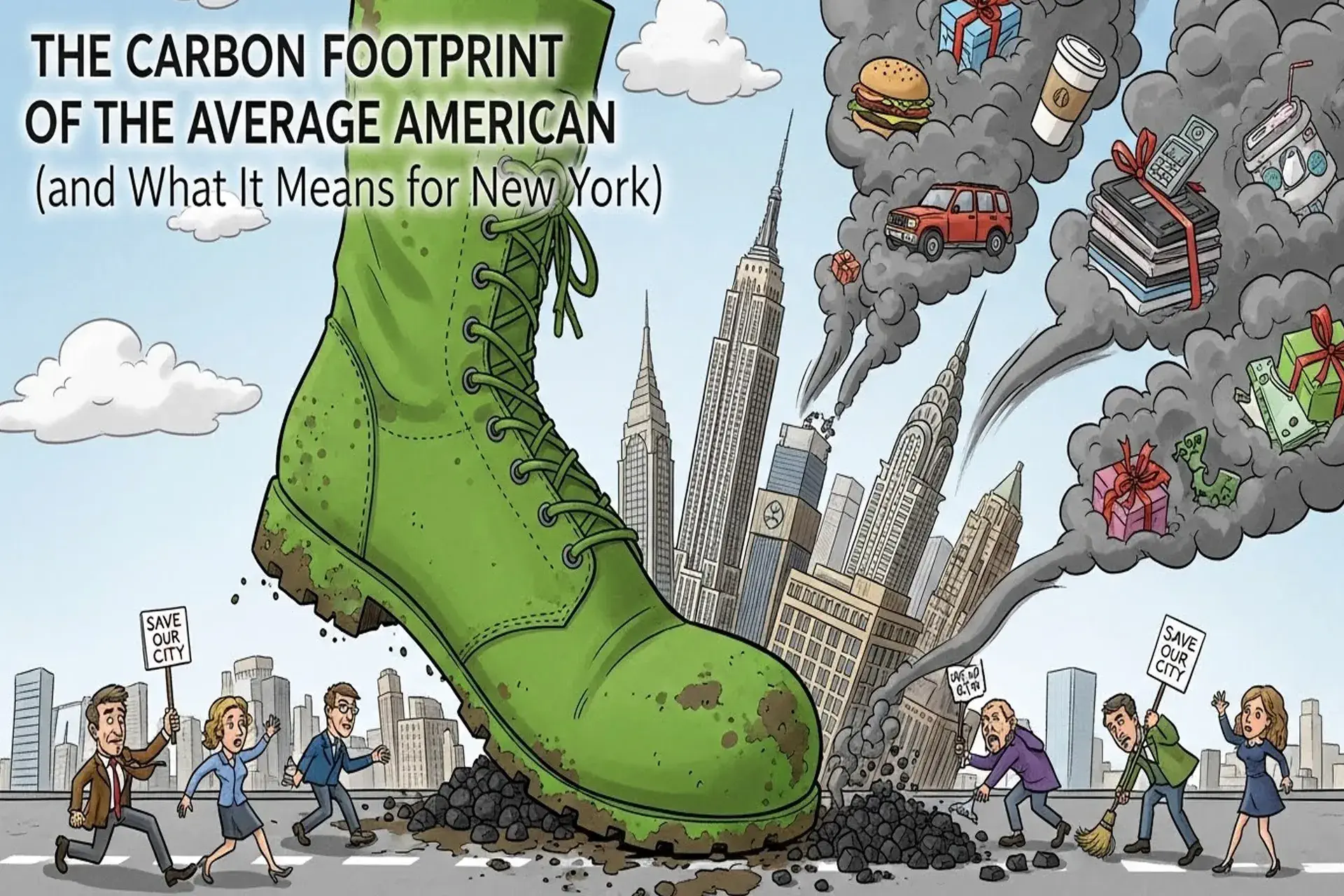New York moves fast, and so does your carbon footprint. Every time the heat turns on, every draft in an older building, and every inefficient appliance quietly raises your energy use and greenhouse gas emissions. In a dense city like ours, those extra emissions directly affect environmental protection, energy costs, and long-term sustainability.
The first step is understanding your carbon footprint. New York’s older buildings and extreme seasons naturally drive higher energy consumption, but reducing emissions does not require major renovations. Small improvements like better insulation, air sealing, and moisture control can significantly lower both your footprint and your monthly bills.
Zavza Seal provides energy-efficient insulation and waterproofing designed to help New York homes and businesses cut emissions at the source. If you want sustainability, comfort, and real savings, you are in the right place.
Get a Free Energy Efficiency Assessment! Find Out How to Reduce Your Property’s Carbon Footprint Today.
What Is a Carbon Footprint?
A carbon footprint is the total amount of greenhouse gas emissions produced by human activity, measured in CO₂e. Everything that uses energy contributes to your footprint, including electricity, transportation, heating and cooling systems, building materials, and even day-to-day habits. Understanding your carbon footprint calculation helps you see where emissions come from and where changes can make the greatest carbon footprint impact.
Carbon Footprint Effects on Environment and Humans
Excessive carbon emissions influence nearly every part of the natural and built environment. Rising temperatures, shifting weather patterns, and ecosystem stress are all direct results of a growing carbon footprint. In New York, dense neighborhoods, older buildings, and coastal exposure make these effects more severe. Humans feel the impact through health challenges, infrastructure strain, and increased risk during extreme weather events.
Negative Effects of a High Carbon Footprint
- Rising Global Temperatures: Increased greenhouse gases trap heat and intensify warming trends.
- Sea-Level Rise: Melting ice and thermal expansion elevate water levels and increase coastal flooding.
- Poor Air Quality: Higher emissions worsen smog, particulate pollution, and respiratory irritation.
- Biodiversity Loss: Species decline as habitats warm, shift, or disappear.
- More Intense Heatwaves: Urban areas experience higher temperatures and greater heat stress.
- Increased Asthma and Respiratory Issues: Polluted air aggravates lung conditions and overall public health.
- Greater Flood Risk: Stronger storms and rising seas increase flooding in vulnerable regions.
- Strain on Energy Systems: Higher temperatures and demand spikes pressure electrical grids.
If You’re Looking for Ways to Lower Your Carbon Footprint, We Offer Easy Financing Options for Home Insulation! Contact Us for a Free Assessment!
Carbon Footprint vs Ecological Footprint
It would be easy to get these two terms confused, but the truth is, they are actually quite different. Carbon footprint measures the pollution we create. Ecological footprint measures the natural resources we use. Together, they show how our lifestyle impacts the planet’s health and long-term sustainability.

The Carbon Footprint of the Average American (and What It Means for New York)
The carbon footprint of the average American, driven by tranadsportation, heating and cooling, and electricity use. Nationally, households generate several tons of CO₂e each year, but New York often differs from these averages in important ways.
New York’s dense population and extensive public transit reduce transportation emissions for many residents. However, older buildings, cold winters, hot summers, and aging heating systems increase energy use and raise overall emissions. Homes and businesses in New York often require more insulation, better air sealing, and updated building materials to keep their carbon footprint in check.

Ways People Can Reduce Their Carbon Footprint
- Use Public Transit or Carpool: Choosing shared transportation reduces emissions from daily travel.
- Upgrade Home Insulation: Better insulation cuts heating and cooling demand throughout the year.
- Seal Air Leaks: Closing gaps around doors, windows, and attics lowers energy loss.
- Install Efficient HVAC Systems: Modern heating and cooling units use less energy and emit fewer greenhouse gases.
- Switch to LED Lighting: LEDs require less electricity and last significantly longer than traditional bulbs.
- Adopt Smart Thermostats: Automated temperature control reduces unnecessary heating and cooling.
- Reduce Household Waste: Recycling, composting, and avoiding single-use products lower emissions from production and disposal.
- Choose Energy-Efficient Appliances: Devices with Energy Star ratings use less electricity and water.
- Limit Air Travel When Possible: Fewer flights help reduce high-impact transportation emissions.
- Support Local and Sustainable Food: Shorter supply chains and eco-friendly farming lower agricultural emissions.
The carbon footprint of companies includes emissions from energy use, transportation, operations, materials, and waste. Most businesses reduce their footprint by tracking emissions through sustainability programs and implementing practical improvements that cut energy use.
Common examples include upgrading commercial insulation, improving HVAC efficiency, reducing waste streams, optimizing lighting, and using smart controls to manage energy.
Zavza Seal actively supports carbon footprint reduction projects for New York businesses by providing insulation upgrades, air sealing, moisture control, and long-term building performance improvements that lower operating costs and emissions.
Ways Companies Can Reduce Their Carbon Footprint
- Upgrade Commercial Insulation: Commercial insulation reduces heating and cooling demand in offices, warehouses, and retail spaces.
- Improve HVAC Efficiency: Modern systems use less energy and cut long-term operating costs.
- Use Smart Building Controls: Automates lighting, HVAC, and equipment schedules.
- Reduce Waste Streams: Improves recycling practices and lowers disposal-related emissions.
- Retrofit with LED Lighting: Cuts electricity use and reduces heat load in commercial interiors.
- Optimize Transportation: Encourage carpooling, EV charging, or route optimization for fleet vehicles.
- Seal Air Leaks: Prevents uncontrolled airflow in large commercial buildings.
The Carbon Footprint of the Construction Industry
The carbon footprint in the construction industry is one of the largest contributors to global emissions. Most of the environmental impact comes from three areas: the production of construction materials, the transportation required to move those materials, and the day-to-day operations on job sites.
Concrete, steel, insulation, and other key building elements release significant CO₂ during manufacturing. Transportation adds another layer of emissions as materials move across the state or country. On-site operations, including heavy equipment, electricity use, and heating or drying processes, also increase total emissions.
New York is responding by adopting greener building codes, increasing efficiency standards, and encouraging the use of low-VOC products and high-performance building materials. Zavza Seal supports this shift with low-VOC insulation, energy-efficient moisture barriers, and building envelope solutions that reduce the overall carbon footprint of construction materials used in local projects.
Ways the Construction Industry Can Reduce Its Carbon Footprint
- Use High-Performance, Low-VOC Materials: Reduces emissions during installation and throughout the building’s life.
- Improve Material Efficiency: Reduce waste by better planning and using recycled or reclaimed materials.
- Optimize Transportation: Source materials locally to cut fuel use and emissions.
- Upgrade Building Envelope Performance: Better insulation and air sealing reduce long-term energy use.
- Adopt Energy-Efficient Equipment: Modern machinery uses less fuel and emits fewer pollutants.
- Implement Smart Site Management: Reduce idle times, schedule efficiently, and limit unnecessary energy use.
- Follow Greener Building Codes: Align with New York’s updated energy standards to reduce operational emissions.
The Carbon Footprint of the Average New York Home and Business and How to Reduce It: Final Thoughts
Reducing your carbon footprint is about more than lowering emissions. It’s about creating healthier homes, more efficient buildings, and a stronger, more resilient New York. Small steps across homes, businesses, and construction industries add up, and citywide improvements are already shaping a greener future. Zavza Seal remains committed to high-performance building envelopes, sustainable construction, and long-term climate resilience throughout the region.
Protect Your Future. Get Your Free Energy Efficiency Audit Today.








